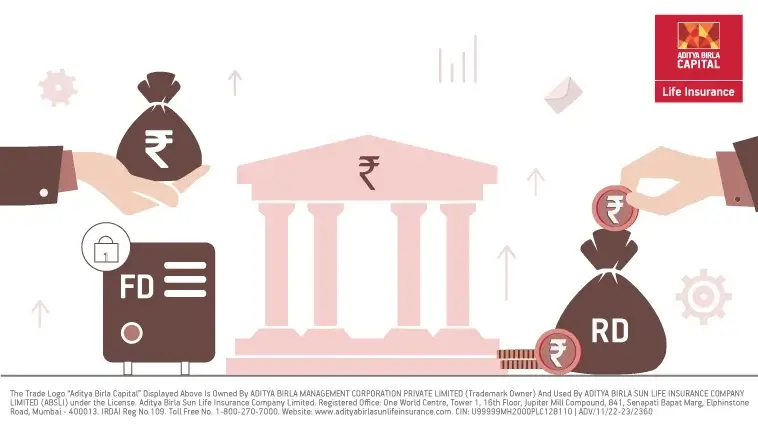Ever found yourself pondering whether to park your savings in a Fixed Deposit (FD) or a Recurring Deposit (RD)? Both are popular savings instruments offered by banks, but they cater to different financial goals and saving habits. Whether you're aiming for a lump sum investment or prefer saving in regular instalments, understanding the differences between FD and RD may help you make a more informed decision. Let’s break down these two options to see which might be the best fit option for your financial aspirations.
What is a Recurring Deposit Account?
A Recurring Deposit (RD) account allows you to deposit a fixed amount of money into your account at regular intervals, typically every month. This type of account is designed to help individuals develop a disciplined approach to saving, offering a fixed interest rate throughout the tenure of the deposit. At the end of the tenure, the account holder receives the principal amount along with the interest earned.
What is a Fixed Deposit Account?
A Fixed Deposit (FD) account is a financial instrument provided by banks that offers investors a higher rate of interest than a regular savings account, until the given maturity date. It requires a lump sum investment for a fixed tenure at an agreed interest rate.
The Difference Between Fixed & Recurring Deposits
-
Duration:
Fixed deposits must be kept for minimum period of atleast seven days, and regular deposits must be kept for at least six months. Both plans have a maximum length of 10 years.
-
Taxation:
The interest you earn on both a fixed deposit and a recurring account is taxed. For RD, the person doesn't have to pay TDS, but they do have to include interest made when they file their ITR (income tax return). If the interest made on a fixed deposit is more than Rs. 10,000, the account holder needs to pay TDS. From April 1, 2019, this cap will be raised to Rs 40,000. If the PAN is given, the TDS is 10%. If it is not, it is 20%.
-
Returns:
If you compare the returns in FD and RD, it looks like FD has better returns. This is because people who have RD accounts put money in every month, which means that interest is made every month. The FD amount is usually only put in one time. It is a lump sum that gets a higher interest rate.
Here's a comparative table highlighting the key differences between Fixed Deposits and Recurring Deposits:
| Feature | Fixed Deposit (FD) | Recurring Deposit (RD) |
|---|
| Investment Type | Lump sum investment. | Regular monthly investments. |
| Interest Rates/Returns | Usually offers higher interest rates compared to RD. | Slightly lower interest rates than FD. |
| Tenure | Flexible, ranging from 7 days to 10 years. | Usually ranges from 6 months to 10 years. |
| Investment Goal | Suitable for those with a lump sum amount to invest. | Ideal for individuals looking to save regularly. |
| Minimum Investment | Can be higher compared to RD. | Lower minimum investment, making it accessible to all. |
| Liquidity | Early withdrawal may attract penalties. | Allows for some flexibility, but early withdrawal penalties apply. |
| Compounding Frequency | Interest is compounded quarterly or annually. | Interest is compounded quarterly. |
Features of a Recurring Deposit Account
A Recurring Deposit (RD) account offers several features designed for systematic savings:
- Systematic Savings: Allows you to save a fixed amount monthly, encouraging regular saving habits.
- Interest Rate: Provides a fixed interest rate for the tenure of the deposit, similar to FDs, but usually slightly lower.
- Flexible Tenure: Tenure options range from 6 months to 10 years, allowing you to align savings with financial goals.
- Loan Against RD: Many banks offer loans against the balance in your RD account, providing financial flexibility in emergencies.
- Minimum Investment: RDs have a low minimum monthly deposit requirement, making it accessible to a wide range of savers.
- Premature Withdrawal: Offers the option for early withdrawal, though it may be subject to penalties.
- Compounding of Interest: Compounding of interest on RD happens quarterly, contributing to the growth of your savings.
Features of a Fixed Deposit Account
Fixed Deposit accounts come with a set of features that make them a preferred choice for investors looking for stable returns:
- Lump Sum Investment: Requires a one-time investment of funds for a fixed period.
- Higher Interest Rates: Generally offers higher interest rates compared to savings accounts, with the rate depending on the tenure and amount.
- Fixed Tenure: Tenure can vary widely, from 7 days to 10 years, offering flexibility in investment planning.
- Guaranteed# Returns: The interest rate is fixed at the time of investment, ensuring guaranteed# returns upon maturity.
- Loan Against FD: Investors can avail loans against FDs up to 90% of the deposit value, providing liquidity without breaking the deposit.
- Premature Withdrawal: FDs can be withdrawn before the maturity date, usually at the cost of a penalty on interest.
- Tax Implications: Interest earned on FDs is taxable. However, tax-saving FDs offer tax benefits* under Section 80C of the Income Tax Act, with a lock-in period of 5 years.
- Renewal and Auto-Renewal Options: FDs come with the option to renew upon maturity. Some banks also offer auto-renewal features.
Both RD and FD accounts have their unique features catering to different financial needs and saving habits. While RDs are ideal for individuals who wish to save regularly over time, FDs are suitable for those who have a lump sum amount and are looking for safe and higher returns over a fixed period.
FDs vs RDs: Which one should you choose?
So, given the many points of difference between a fixed deposit and a recurring deposit, which one should you choose? Here is a quick set of pointers to guide you.
A fixed deposit would be ideal for you if -
● You have a lump sum amount ready to be invested
● You want to earn guaranteed# returns on your capital
● You have a bank account
● You need a regular source of additional or alternate income
A recurring deposit would be ideal for you if -
● You have a small sum remaining from your earnings each month
● You want to invest those small sums in a safe manner and earn assured returns
● You do not have a lump sum amount at hand
Conclusion
Choosing between a Recurring Deposit (RD) and a Fixed Deposit (FD) ultimately depends on your financial goals, saving habits, and liquidity needs. RDs are ideal for individuals looking to build their savings gradually over time through regular monthly contributions. They encourage disciplined saving habits and are particularly suitable for those with a steady income who may not have a lump sum to invest upfront. On the other hand, FDs are perfect for investors who have a lump sum amount and desire higher interest earnings with the stability of guaranteed# returns. FDs offer the flexibility of choosing your investment tenure and provide the opportunity to earn a higher interest rate compared to most savings accounts, making them suitable for short-term and long-term savings goals.










